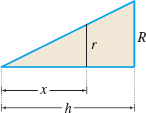EXAMPLE 1Using the Slicing Method to Find the Volume of a Cone
Use the slicing method to verify that the volume of a right circular cone having radius R and height h is V=13πR2h.
Solution We position the cone with its vertex at the origin and its axis on the x-axis, as shown in Figure 39.
The cone extends from x=0 to x=h. The cross section at any number x is a circle. To obtain its area A, we need the radius r of the circle. Embedded in Figure 39 are two similar triangles, one with sides x and r; the other with sides h and R, as shown in Figure 40. Because these triangles are similar (AAA), corresponding sides are in proportion. That is, rx=Rhr=Rhx
So, r is a function of x and the area A of the circular cross section is A=A(x)=π[r(x)]2=π(Rhx)2=πR2h2x2
Similar triangles are discussed in Appendix A.2, pp.A-13 to A-14.
Since A is a continuous function of x (where the slice was made), we can apply the slicing method. The volume V of the right circular cone is V=∫baA(x) dx=∫h0πR2h2x2 dx=πR2h2∫h0x2 dx=πR2h2[x33]h0=πR2h3 cubic units
